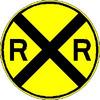
General
The Motor Vehicle Act requires that the driver of a vehicle approaching a railway track proceed with caution to avoid a collision between the vehicle and an approaching train.
When to Stop
- a clearly visible electrical or mechanical signal device gives warning of the approach of a train
- a crossing gate is lowered or a flagger is giving a signal of the approach or passage of a train
- a train is approaching and is within approximately 500 m of a crossing
- by reason of the train's speed or nearness to the crossing it is an immediate hazard
- there is a stop sign posted at the crossing
Where do You Stop?
Your vehicle must be stopped within 15 metres, and no less than 5 metres from the nearest rail. No part of your vehicle may be on or over the tracks.
Trucks and Buses
Drivers of vehicles carrying poisons, explosives or flammables, and drivers of buses or school buses carrying passengers must stop at an uncontrolled railway crossing, even if a train is not approaching.
The driver must look both ways and listen for an approaching train.
When to Proceed
If the crossing is equipped with a barrier, a driver must stop or remain stopped if the barrier is lowering, raising or stopped in a horizontal position.
If the crossing is equipped with flashing red lights or a stop sign, the driver must stop, look and may proceed if it is safe.
The driver must cross the tracks without shifting gears.
Multiple Tracks at a Railway Crossing
Beware of a railway crossing where there is more than one set of tracks. If a train appears to be stopped at the crossing remember it could be waiting for another train to pass on the other set of tracks. If you drive across the tracks without checking the second crossing you could be struck by the other train.
Stuck on the Tracks
If your vehicle stalls or gets stuck on the tracks, move everyone at least 30m away and contact the railway immediately. The emergency phone number is found on a blue sign at or near the crossing along with the subdivision name and mile post identifying the location.
If you cannot find the blue sign, call 911.
Operation Lifesaver
Operation Lifesaver Canada provides resources to educate Canadians about the hazards surrounding railway property and trains.
Share This Article
- Log in to post comments
